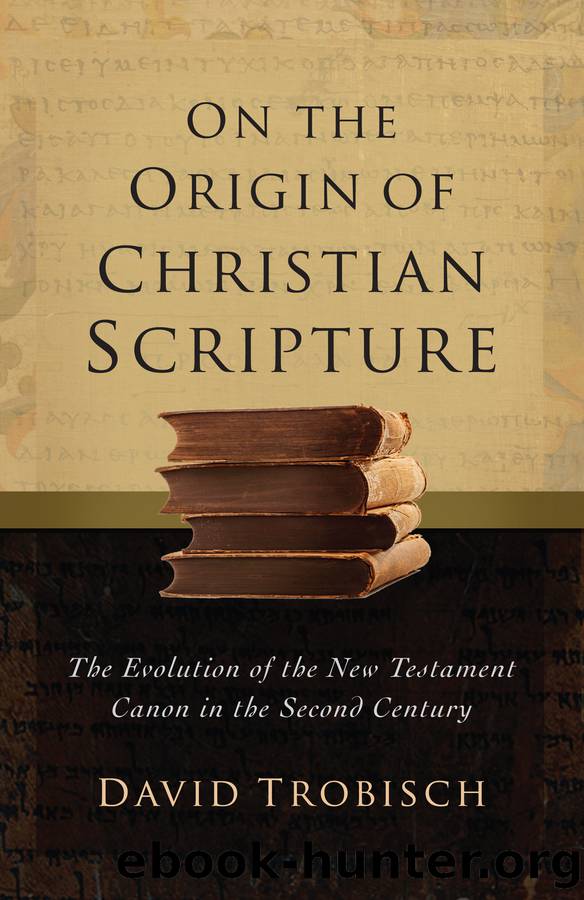On the Origin of Christian Scripture by David Trobisch;

Author:David Trobisch; [David Trobisch]
Language: eng
Format: epub
ISBN: 9781506486154
Publisher: National Book Network
Published: 2023-08-15T00:00:00+00:00
Ten Letters of Paul
Opening and Conclusion
Gospel according to John, 1 John, and Revelation of John show that the historical publisher favors the opening and conclusion of a book for editorial comments when he speaks with the voice of Theophilus. The beginning of Gospel according to Luke and the end of Letter to Romans also contain elaborate unmarked interpolations. Therefore, the introduction to the Fourteen-Letters-of-Paul volume and its conclusion are typical places for the historical publisher to consider interpolations to the traditional text.
In the very first sentence of Letter to Romans, Paul endorses âthe gospel of Godâ and the âprophets in the holy scriptures,â which to a later audience reads like an endorsement of the Four-Gospel volume and the authority of Jewish Scriptures.19 More specifically, literary Paul defines the content of the âgospel of Godâ as a proclamation that Jesus was related to âDavid according to the fleshâ and that âaccording to the spiritâ Jesus was âSon of God,â which is demonstrated in his âresurrection from the dead.â20
The Marcionite Gospel lacks an explanation of where Jesus came from at the beginning and where he went at the end of the book, which does not satisfy Paulâs definition of the âgospel of God.â Markâs gospel book also lacked an explanation of how Jesus of Nazareth could possibly be related to the house of David, and it offered not a single appearance of the resurrected Christ. Gospel according to Luke, however, perfectly fulfills the requirements of Paulâs definition: Luke presented Jesus as the fulfillment of prophetic promises; he explained how Jesus was related to King David; he reported two appearances of the resurrected Christ in Jerusalem before the gospel book concluded.21 Paulâs definition of his apostleship as âto bring about the obedience of faith among all the nationsâ reflects Lukeâs storyline in his book about the apostles, which follows Paul from Antioch in Syria through Asia Minor to Europe.22
The connections between the beginning of Letter to Romans to the Four-Gospel volume, the link to the storyline of Acts of Apostles, and the canonical editorsâ concept of promoting Jewish Scriptures as promises that are fulfilled in Jesus, so clearly represent the canonical editorsâ agenda that one must suspect a rather heavy-handed interpolation to the Marcionite Edition. It would explain the convoluted sentence structure of the untypically long opening. Unfortunately, the wording of this passage in the Marcionite Edition is not attested.23
The Fourteen-Letters-of-Paul volume concludes with the Letter to Philemon. In this letter, Paul asks Philemon to take back a slave, Onesimus, who had run away. Paul writes a legally binding promissory note with his own hand that he âwill repayâ Philemon all damages that the loss of his slave may have caused.24 Again, Theophilus signals that he had access to the autograph. And even for the most casual readers, the characters mentioned at the end of the letter link the Fourteen-Letters-of-Paul volume to Theophilusâs editorial narrative.
Epaphras, my fellow prisoner in Christ Jesus, sends greetings to you, and so do Mark, Aristarchus, Demas, and Luke, my fellow workers.
Download
This site does not store any files on its server. We only index and link to content provided by other sites. Please contact the content providers to delete copyright contents if any and email us, we'll remove relevant links or contents immediately.
| Apocrypha & Pseudepigrapha | Dead Sea Scrolls |
The Five People You Meet in Heaven by Mitch Albom(3476)
The Secret Power of Speaking God's Word by Joyce Meyer(2983)
Real Sex by Lauren F. Winner(2968)
Name Book, The: Over 10,000 Names--Their Meanings, Origins, and Spiritual Significance by Astoria Dorothy(2940)
The Holy Spirit by Billy Graham(2894)
0041152001443424520 .pdf by Unknown(2785)
ESV Study Bible by Crossway(2733)
How The Mind Works by Steven Pinker(2732)
Ancient Worlds by Michael Scott(2627)
Churchill by Paul Johnson(2510)
The Meaning of the Library by unknow(2508)
The ESV Study Bible by Crossway Bibles(2504)
The Gnostic Gospels by Pagels Elaine(2472)
MOSES THE EGYPTIAN by Jan Assmann(2374)
Jesus by Paul Johnson(2312)
City of Stairs by Robert Jackson Bennett(2309)
The Complete Dead Sea Scrolls in English (7th Edition) (Penguin Classics) by Geza Vermes(2237)
Ancient Near Eastern Thought and the Old Testament by John H. Walton(2196)
The Nativity by Geza Vermes(2181)
